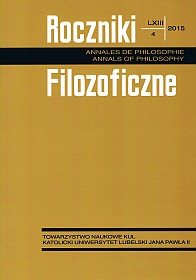Epistemologiczno-eksplanacyjny wymiar problemu niejęzykowych myśli w koncepcji José Luisa Bermúdeza
Abstrakt
Podejmując problem niejęzykowych myśli, Bermúdez rozważa go przede wszystkim na dwóch płaszczyznach: epistemologicznej i eksplanacyjnej. Płaszczyzna epistemologiczna dotyczy tego, jak możliwe jest przypisywanie myśli do istot nieposługujących się językiem (dalej: NC) oraz czy możliwe jest poznanie treści niejęzykowych myśli. Do rozwiązania tego problemu Bermúdez posłużył się koncepcją semantyki sukcesu, która umożliwia poznanie zawartości przekonań i pragnień oraz zastosowanie wyjaśniania psychologicznego. Płaszczyzna eksplanacyjna dotyczy natomiast takiej atrybucji myśli do NC, która odpowiednio wyjaśniałaby ich zachowanie. W tym celu Bermúdez rozszerza pojęcie racjonalności do NC przez wyróżnienie jej różnych poziomów. Ponadto wyodrębnia protologikę, ukazującą, jak praktyczne rozumowanie może być przypisywane do NC. Główne zarzuty w stosunku do jego stanowiska dotyczą m.in. relacji między myśleniem a wnioskowaniem, stosowanej metodologii oraz rozszerzonego pojęcia racjonalności.
Bibliografia
Bermúdez, José Luis. The paradox of self-consciousness. Cambridge: MIT Press, 2000.
Bermúdez, José Luis. „Rationality and Psychological Explanation Without Language”. W: Reason and nature: essays in the theory of rationality, red. José Luis Bermúdez i Alan Millar, 233–264. Oxford: Clarendon Press, 2002.
Bermúdez, José Luis. Thinking without Words. New York: Oxford University Press, 2003.
Bermúdez, José Luis. „Nonconceptual Content: From Perceptual Experience to Subpersonal Computational States”. W: Essays on Nonconceptual Content, red. York H. Gunther, 183–216. Cambridge: MIT Press, 2003.
Bermúdez, José Luis. Philosophy of Psychology. A contemporary introduction. New York: Routledge, 2005.
Blackburn, Simon Practical Tortoise Raising: and other philosophical essays. New York: Oxford University Press, 2012.
Davidson, Donald. „Actions, reasons and causes”. Journal of Philosophy 60 (1963), 23: 685–700.
Davidson, Donald. Essays on Actions and Events. Oxford: Oxford University Press, 1980.
Dotov, Dobromir G., Lin Nie i Matthieu M. de Wit. Zrozumieć afordancje: przegląd badań nad główną tezą Jamesa J. Gibsona, przełożyli D. Lubiszewski i Nelly Strehlau. http://avant.edu.pl/wp-content/uploads/DDLNMW-Zrozumiec-afordancje.pdf [dostęp: 19.04. 2015].
Dutkowska, Anna. „Udział nauk szczegółowych w badaniach umysłów prostych”. W: Człowiek wobec wyzwań współczesnego świata, red. Maria Białonoga-Gosik, Tomasz Łach, Ewelina Bal i Konrad Zaborowski, 117–125. Lublin: Wydawnictwo KUL, 2013.
Fodor, Jerry. „More Peanuts”. London Review of Books 25 (2003), 19: 16–17.
Gierasimczuk, Nina Teoretyczny model nabywania języka według Quine’a, http://kf.mish.uw.edu.pl/kog/kog_nin.pdf [dostęp: 19.04.2015].
Łastowski, Krzysztof, i Magdalena Reuter. Ewoluujące umysły. Koncepcje, hipotezy, argumenty empiryczne. W: Przewodnik po filozofii umysłu, red. Marcin Miłkowski i Robert Poczobut, 651–688. Kraków: Wydawnictwo WAM, 2012.
Mellor, D.H. Mind, Meaning and Reality. New York: Oxford University Press, 2012.
Miłkowski, Marcin, i Robert Poczobut. „Czym jest i jak istnieje umysł”. Diametros 2005, 3: 27–55.
Schetz, Adriana. „O tak zwanym problemie prostych umysłów”. Diametros 2011, 30: 41–60.
Trojan, Maciej. Na tropie zwierzęcego umysłu. Warszawa: Wydawnictwo Naukowe SCHOLAR, 2013.
Żegleń, Urszula. „Głos w debacie na temat: ‘Czym jest i jak istnieje umysł’”. Diametros 2005, 3: 169–172.
Copyright (c) 2015 Roczniki Filozoficzne

Utwór dostępny jest na licencji Creative Commons Uznanie autorstwa – Użycie niekomercyjne – Bez utworów zależnych 4.0 Międzynarodowe.





